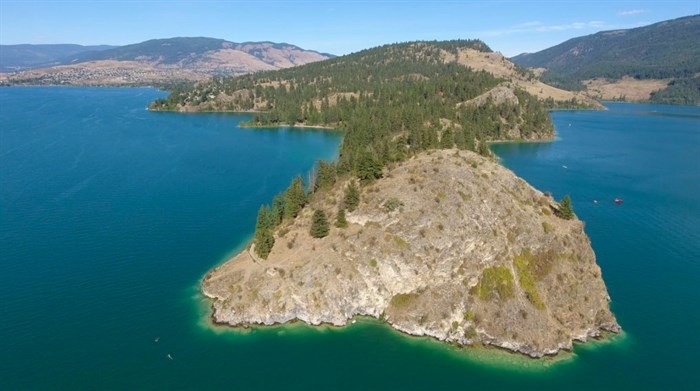
Turtles Head Point (or better known as Rattlesnake Point) in Kalamalka Lake Provincial Park.
Image Credit: Submitted/Kalamalkalakepark.org
August 15, 2021 - 7:00 AM
Kalamalka Lake Provincial Park was the second busiest park in B.C. last year, next to Manning Park, with some 300,000 visitors.
Yet, unlike its western neighbour, there aren’t the kind of paved roads leading to highlights of the park, like Cosens Bay Beach and Cougar Canyon.
“The road is a bit challenging,” Peter Horsley, president of the Friends of Kalamalka Lake Park told iNFOnews.ca. “It’s not something you’d want to drive in the winter for sure.”
He doesn’t need to tell that to the dozens of residents living at Cosens Bay along the Kalamalka Lake shoreline whose only road access is through the park.
“I have never stopped fighting for the public road to be safe, accessible for all of the public, to our properties but also to Cosens Bay public beach,” Cosens Bay resident Alice Klim told iNFOnews.ca.
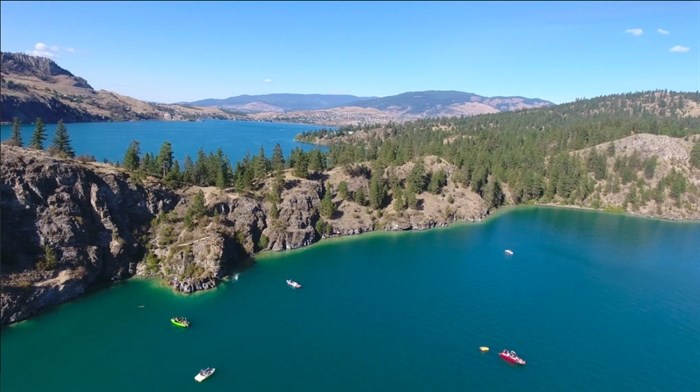
Kalamalka Lake Provincial Park
Image Credit: Submitted/Kalamalkalakepark.org
She led a court battle against the province to get access to that road. Residents won that battle but haven’t gotten much in the way of road improvements.
Nor will they if people like Horsley get their way.
“Our society is committed to preserving and protecting the environmental integrity of the park,” he said. “Parking lots don’t help. Widening roads don’t help.”
A recent suggestion by the province to build a parking lot in the park got nixed after 3,500 people signed a petition against it within about 10 days, Horsley said.
“There’s a group, certainly, out in Cosens Bay who would like their property values to go up by having better access, there’s no doubt about it,” he said. “I don’t blame them. But, when they bought the property out there — for the very good price they got it for — that was because it was somewhat remote, mostly accessed by boat seasonally.
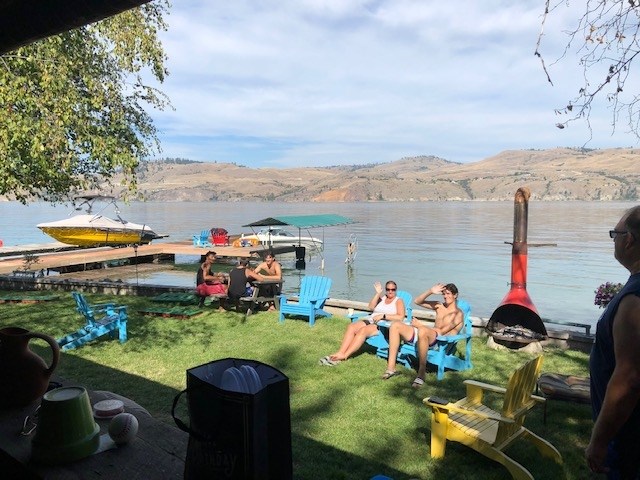
Alice Klim's family on her home at Cosens Bay.
Image Credit: Submitted/Alice Klim
“We certainly don’t support widening that road. Those are cabins. They’re not supposed to be palatial houses or whatever. Most of the people, at this point, are still living off the grid.”
Those are fighting words to someone like Klim, whose research through provincial archives helped her turn the tide and defeat the provincial government over Cosens Bay residents’ right to use that road.
This troubled tale began in 1883 when Cornelius Cosens homesteaded at Cosens Bay, getting a land grant in 1886, the same year he applied for a highway.
“It was one of only two applications for a highway to be created in B.C. in that year,” Klim said. “Highway 97 between Vernon and Kelowna was not built until 1901. There were no roads built yet from Hope to Princeton or through the Fraser Canyon. There were only crude trails for pack horses as a result of the needs of Fur Traders and the Gold Rush. Cars at that time had to travel down into the United States and up into Canada to avoid the tough B.C. mountain terrain.”
In order to qualify for a land grant, homesteaders had to live year-round on their property for five years and make improvements.
They also built roads that could be classified as highways simply by putting a notice in a newspaper, which the early settlers did.
The Cosens Bay settlers were working on their homesteads just after Vernon incorporated in 1892. At the time, Klim said, the Canadian government was encouraging settlement in areas like the Okanagan.
At about the same time, 1891, Lord Aberdeen bought the Forbes Vernon Ranch and renamed it Coldstream Ranch. While the Aberdeens returned to England, they retained the ownership of the ranch and encouraged immigration from that country.
“In the early part of the 20th Century, the North Okanagan area was expected to be a generator of tourist revenue,” Klim wrote. “Vernon was the largest city then in the Interior, and the first to become incorporated in the Okanagan Valley. This led to the beautiful Cosens Bay area receiving lots of attention as a recreational area and a future area for development.
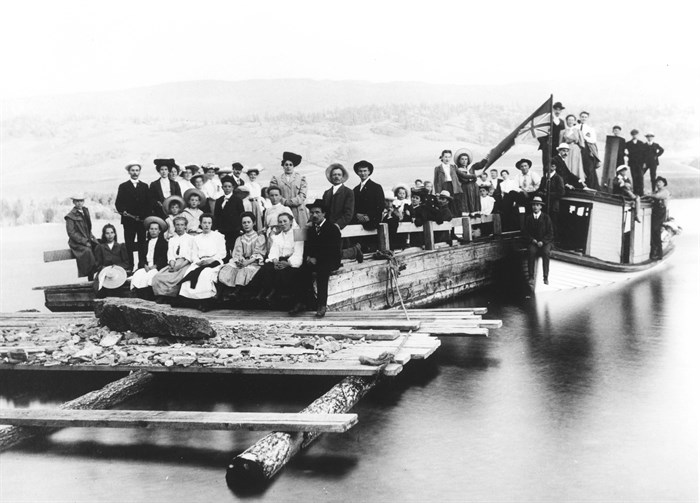
Cosens Bay Beach was a popular summer destination in the early part of the last century. This shows members of the Vernon Methodist Church on a barge near Kal Beach. To the right is the Maud Allan, who was taking the barge to Cosens Bay. Identified are: Emma, Lisa, Amy, and Percy Tennant; Vera, Gertrude, Pearl, John, Doug and Georgina Glover; Charlie Wylie; Mrs. Pound and Violet Hall. Alex and Margaret Shand.
Image Credit: Image Courtesy: Vernon Museum and Archives – Photo No. 3850
“During 1910-1915 B.C. spent more money upgrading Cosens Bay Road than they did on Okanagan Landing Road which served the Okanagan Lake Sternwheeler at that time transporting cargo and passengers up and down the Okanagan Valley,” she said.
Two major events halted further development and prevented Cosens Bay from becoming a significant community.
First was the railway that went through Vernon to Okanagan Landing in 1910 and, eventually, Kelowna.
“The arrival of the railway had profound effects as development centered around the location of railway stations,” Klim said. “That changed what would likely have happened in Cosens Bay. It was not practical for commercial development so far away from the railway station in downtown Vernon.”
The second big event was the First World War.
With so many English settlers rushing back to their mother country to help in the war effort, with families soon to follow, the homesteads and the roads serving them fell into disuse.
Coldstream Ranch started buying up the homesteads that are in what is now Kalamalka Park.
Three large properties never sold.
“They were owned by people in the area that had money and obviously had the ability to keep them as their summer places,” Klim said.

Alice Klim with a nephew.
Image Credit: Submitted/Alice Klim
The real development of what is now the Cosens Bay neighbourhood started in the 1950s when some of those landowners subdivided and people built what were initially summer cabins.
“Around 1960, the province decided they wanted that whole area for a Class A park,” Klim said. “They wanted to buy the whole area all the way down to Oyama and have just park and no private properties. Their hope was to devalue our properties by claiming there was no road access, and once there was no road access, as people sold off, at more reasonable rates, they would try to buy them up and put them into a Class A park.”
That’s not quite the way Horsley sees it.
As he understands it, the land was put up for sale and a developer was interested in buying it up for condos, a golf course and marina.
“Basically, taking a pristine grasslands – of which we have very few left in the Southern Interior – and developing it,” he said.
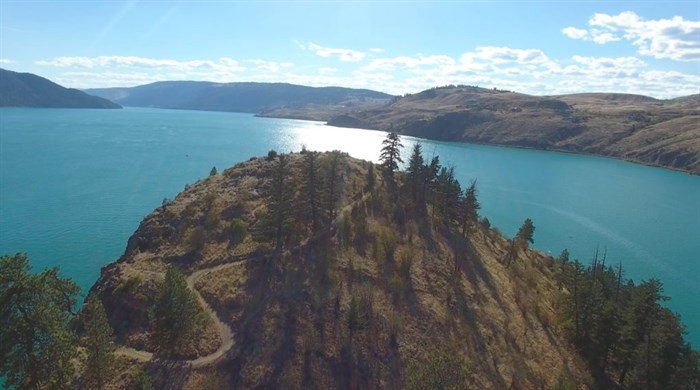
Image Credit: Submitted/Kalamalkalakepark.org
Instead, a local naturalist group lobbied hard and convinced the province to buy it for a park, much of it sensitive grasslands with a number of endangered and threatened species.
Kalamalka Lake Provincial Park was created in 1975 with the Cosens Bay residents nestled into one side of the bay and outside the park.
From that point until 1992, the road was gated and residents were given keys.
“What we really had was access to a locked off subdivision, which was good for a lot of us in that we were having vandalism, because people would drive out there and ransack your cabin,” Klim said. “It was mostly summer places so people were happy to have it gated and believed the road would be upgraded because the province gave the impression that they might develop campgrounds in there and have different levels of development.
“Then it became very political. A strong group of political activists didn’t want anybody driving in there. They wanted only walk-in access. They pushed hard for the government to take the position that we didn’t have any access.”
The activists won that battle.
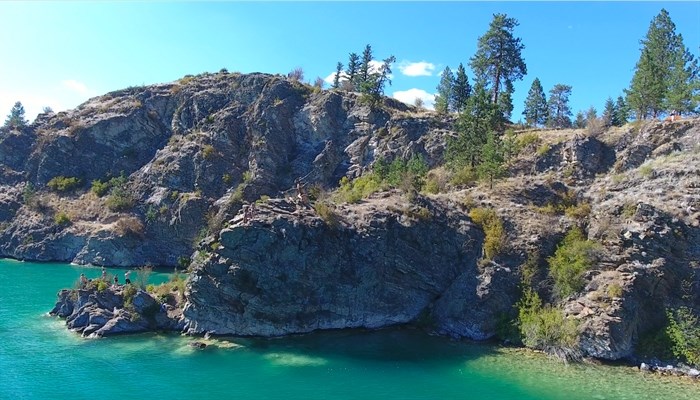
'The Cliffs' on Rattlesnake Point face east into Cosens Bay.
Image Credit: Submitted/Kalamalkalakepark.org
“In 1992, the province got enough courage to tell us we would no longer have any access,” Klim said. “The locks on the gates would be changed and we would have to use water access only.”
But the province chose the wrong people to pick a fight with.
In 1993, residents took the government to court over the loss of road access and lost.
That galvanized Klim to spend hours pouring through provincial archives and searching out records dating back to the pioneer days when settlers built the highways.
Armed with that evidence and some pretty harsh accusations, the community went back to court in 1996 and won.
“I strongly disagree with the government that subdivision of D.L. 1272 in 1957 could have been approved with water access only restrictions,” Klim wrote in one of her reports. “The 1884 Land Act guaranteed access to Crown Grants. The Land Title Act would not allow any restrictions to be placed on title if roads were available. The evidence is overwhelming that fraud has been administered to deny the roads.”
The court agreed and road access was granted.
That doesn’t mean the war is over.
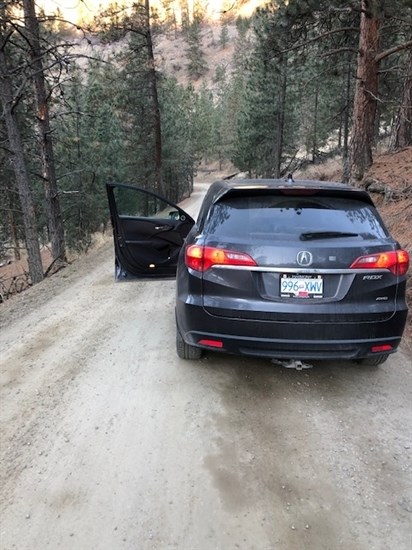
This shows how narrow the Cosens Bay Road is.
Image Credit: Submitted/Alice Klim
To this day, the residents are fighting to get the road better maintained and upgraded with proper ditching.
It’s well used by park visitors but there needs to be a better parking area for horse trailers, Klim said.
“A parking lot near the beach for seniors and young families and handicapped can be tucked behind trees so it does not change the natural view from the water,” she said.
Another parking area is needed that is large enough for the numerous horse trailers visitors bring to the park, she added.
The existing road is narrow, with blind corners and can be dangerous.
Last winter a vehicle slid off the road and the police car sent to help followed it into the ditch.
It also has to accommodate large trucks that are needed to deliver things like propane, since the province is denying residents access to electricity.
Residents are looking into having a line sunk in Kalamalka Lake that will resurface on the east side of the lake along the old road to Oyama to provide them with electricity.
There may yet be a campground and parking lot in the park. As Horsley understands it, there are discussion happening between the province and a Cosens Bay farm owner that would allow for a separate access road to a campground that’s outside the existing park boundary.
That would likely increase park use.
The COVID-generated influx of people last summer did put pressure on delicate environmental areas and species in what “really amounts to a wildlife refuge,” Horsely said.
“These animals, this flora and fauna, they can’t move away,” he said. “Our opinion is, come and visit the park, leave nothing but footprints, take nothing but photos. There’s fewer and fewer places available like this, especially so close to an urban area. Our society is committed to preserving and protecting the environmental integrity of the park.”
For Klim and other Cosens Bay residents, they just want to retain and upgrade road that their predecessors built when they homesteaded that land more than 100 years ago.
To contact a reporter for this story, email Rob Munro or call 250-808-0143 or email the editor. You can also submit photos, videos or news tips to the newsroom and be entered to win a monthly prize draw.
We welcome your comments and opinions on our stories but play nice. We won't censor or delete comments unless they contain off-topic statements or links, unnecessary vulgarity, false facts, spam or obviously fake profiles. If you have any concerns about what you see in comments, email the editor in the link above.
News from © iNFOnews, 2021